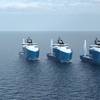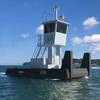USCG Welcomes Cutter Hamilton to Fleet
Coast Guard Cutter Hamilton, the first national security cutter homeported on the East Coast, entered into active service today at Union Pier Terminal in downtown Charleston.
The commissioning ceremony for the Coast Guard’s largest and newest 418-foot cutter was presided by Vice Adm. William “Dean” Lee, Coast Guard Atlantic Area commander. Commandant of the Coast Guard, Adm. Paul F. Zukunft, delivered the keynote address.
“Together with my shipmates, we’re beginning the most important milestones in the life of a cutter,” said Capt. Doug Fears, Hamilton’s commanding officer and the most senior member of the crew. “The Cutter Hamilton is now officially in active service to execute the most challenging maritime security, law enforcement, and national defense missions.”
While being “new” to the Coast Guard is the highlight of the ceremony, Cutter Hamilton’s most enthusiastic crewmembers are just as new to the Coast Guard. Some reported straight out of basic training, and ready for the journey.
“I think it’s awesome to be part of the commissioning ceremonies and to be a plankowner,” Seaman Ryan J. Dalton, one of the cutter’s most junior members, said. “I’m excited and humbled to have this experience to start my Coast Guard career. It can’t get any better than this.”
Lee heartily congratulated the Hamilton crew and offered a leadership advice.
“As the commissioning crew of the first National Security Cutter on the East Coast, you have the unique opportunity to chart the course for the National Security Cutters that follow,” said Lee. “Hard work, dedication and commitment will guarantee that you, the crew and the CGC Hamilton remain ‘Semper Paratus.’ You have my full confidence and trust for the task at hand.”
Fears read his orders and directed the national ensign and commissioning pennant to be hoisted. He then asked permission from the Commandant of the Coast Guard to set the first watch, officially placing the Coast Guard Cutter Hamilton in commission.
Ship sponsor Mrs. Linda Kapral Papp, spouse of retired Coast Guard Commandant Adm. Bob Papp, ordered the ship to come to life. Hamilton’s 117 crewmembers climbed the brow and manned the rails to emphasize the Coast Guard’s newest ship as the centerpiece of the ceremony.
Commissioning is the act of placing a Coast Guard cutter in active service. Modern ships are prepared for service in a much different manner than the ships under sail of yesterday, yet the ceremonies for honoring the traditions of the past are preserved through the commissioning ceremony.
The Flagship of the Atlantic cutter fleet is the sixth cutter to be named after Alexander Hamilton, who is also revered as the “Father of the Coast Guard.” As the Secretary of the Treasury in 1790, he established the Revenue Cutter Service (precursor to the Coast Guard) and built the first 10 cutters to enforce tariff laws. One of the cutters, South Carolina, was homeported in Charleston in 1792 to patrol the Atlantic coastline of her namesake state.
During the “Nullification Crisis” in 1832, the federal government ordered five revenue cutters to Charleston Harbor to enforce the tariff laws and defend customs officers when the state of South Carolina challenged national excise taxes.
Following the commissioning, the cutter and its crew will undergo more training and certification until it deploys next year to conduct maritime law enforcement missions throughout the Western Hemisphere.
Legend-class NSC’s are the largest and the most technologically advanced vessels in the Coast Guard fleet that is replacing the antiquated the 378-foot high endurance cutters from the 1960s. The NSC is 418 feet long and has a top speed of 28 knots and a range of 12,000 nautical miles. It is capable of patrolling in excess of 90 days.












